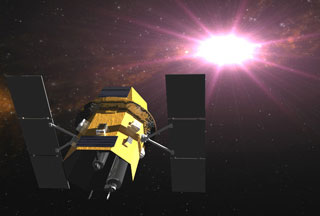Swift Gamma-Ray Burst Explorer: An artist's concept of the Swift Gamma-Ray Burst Explorer catching a gamma-ray burst.
Credit: NASA
So let me tell you about the Swift Gamma-Ray Burst Explorer mission. It’s helping with the problem of detecting and locating gamma-ray sources so that we can study them.
Gamma-ray bursts are very luminous explosions. They’re like having a lighthouse blink at us from the farthest reaches of space. The problem is they’re highly energetic but very brief – they only last a few seconds to a few minutes. Unless you have a wide-field telescope like a coded-aperture, you will miss it.
The scientific objectives of the Swift mission are to determine the origin of gamma-ray bursts, and to use these to understand the early Universe. What we’ve learned is that even though gamma-ray bursts are really bright and you’d think that they’re occurring just next door to the solar system, they’re actually tremendously energetic explosions in distant galaxies. Most occur when massive stars run out of nuclear fuel and the core of the star collapses into a black hole or neutron star. When this happens, gas jets punch through the surface of the star and blast into space. The gas around the star is heated, generating the short-lived afterglows at longer wavelengths. What we’re doing with Swift is using those really bright flashes of gamma rays to study what galaxies and stars were like in the early Universe.
Naked-Eye Gamma-ray Burst Model for GRB 080319B: This record-setting GRB had an afterglow so bright that it was visible to naked-eye observation. Gamma-ray bursts that are longer than two seconds are caused by the detonation of a rapidly rotating massive star at the end of its life. Jets of particles and gamma radiation are emitted in opposite directions from the stellar core as the star collapses. In this model, a narrow beam of gamma rays is emitted, followed by a wider beam of gamma rays. The narrow beam for GRB 080319B was aimed almost precisely at the Earth, which made it the brightest gamma-ray burst observed to date by NASA's Swift satellite.
Credit: NASA/Swift/Cruz deWilde


